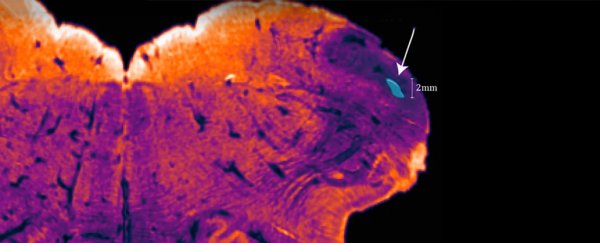It turns out we humans may have an extra type of thinky bit that isn't found in other primates. A previously unknown brain structure was identified while scientists carefully imaged parts of the human brain for an upcoming atlas on brain anatomy.
Neuroscientist George Paxinos and his team at Neuroscience Research Australia (NeuRA) have named their discovery the endorestiform nucleus - because it is located within (endo) the inferior cerebellar peduncle (also called the restiform body). It's found at the base of the brain, near where the brain meets the spinal cord.
This area is involved in receiving sensory and motor information from our bodies to refine our posture, balance and movements.
"The inferior cerebellar peduncle is like a river carrying information from the spinal cord and brainstem to the cerebellum," Paxinos told ScienceAlert.
"The endorestiform nucleus is a group of neurons, and it is like an island in this river."
Neuroscientist Lyndsey Collins-Praino from Adelaide University, who was not involved in the study, told ScienceAlert that Paxinos' discovery is "intriguing".
"While one can speculate that the endorestiform nucleus may play a key role in [the functions of the inferior cerebellar peduncle], it is too early to know its true significance," she added.
Paxinos confirmed the existence of this brain structure while using a relatively new brain staining technique he developed to make images of the brain tissues clearer (and surely also prettier!) for the latest neuroanatomy atlas he has been working on.
These stains target cell products actively being made - chemicals in the brain such as neurotransmitters, providing a map of brain tissues. This helps to differentiate the neuron groups by their function - rather than just the traditional way of separating them by how the cells look - revealing what is known as the chemoarchitecture of the brain.
"The endorestiform nucleus is all too evident by its dense staining for [the enzyme] acetylcholinesterase, all the more evident because the surrounding areas are negative," Paxinos explained.
"It was nearly the case the nucleus discovered me, than the other way around."
In fact, Paxinos had been receiving clues that the endorestiform nucleus existed for decades. In a procedure called a therapeutic anterolateral cordotomy - a surgery to achieve relief from extreme and incurable pain by cutting spinal pathways - he and his colleagues had noticed that the long fibres from the spine seemed to end around where the endorestiform nucleus was found.
"It has been staring at me from the anterolateral cordotomies and also from the chemical stains I use in my lab," he told ScienceAlert.
The location of this elusive brain bit leads Paxinos to suspect it may be involved in fine motor control - something also backed up by the fact that this structure has yet to be identified in other animals, including marmosets or rhesus monkeys.
"I cannot imagine a chimpanzee playing the guitar as dexterously as us, even if they liked to make music," Paxinos pointed out.
Humans have brains at least twice as big as chimpanzees (1,300 grams vs 600 grams, or 2.9 lbs vs 1.3 lbs), and a larger percentage of our brain neuronal pathways that signal for movement make direct contact with motor neurons - 20 percent compared to 5 percent in other primates.
So, the endorestiform nucleus may be another unique feature in our nervous system, although it's too soon to tell just yet. Paxinos is set to do some work in chimpanzees soon.
In order to discover what function the endorestiform nucleus might serve, we may have to wait for higher resolution MRIs capable of studying it in a living person.
Comparing the normal brains studied for the atlas with those from people with known abnormalities might also lead to some insights.
"Neuroanatomy is critical for serving as the foundation that we build a knowledge of both normal and abnormal function upon, but, at this time, it is simply impossible to know what implications this discovery may have for neurological or psychiatric disease," Collins-Praino told ScienceAlert.
"Investigations into the functionality of this nucleus in the coming years will be key in answering these questions."
Paxinos, who has 52 brain-mapping books under his belt, plans to keep using this new staining technique to thoroughly search our brains for more bits and compare them across species, to obtain a greater understanding on how they work.
This discovery is yet to be examined by peer-review, but details of the new brain area can be found in Paxinos' latest atlas, titled Human Brainstem: Cytoarchitecture, Chemoarchitecture, Myeloarchitecture.
